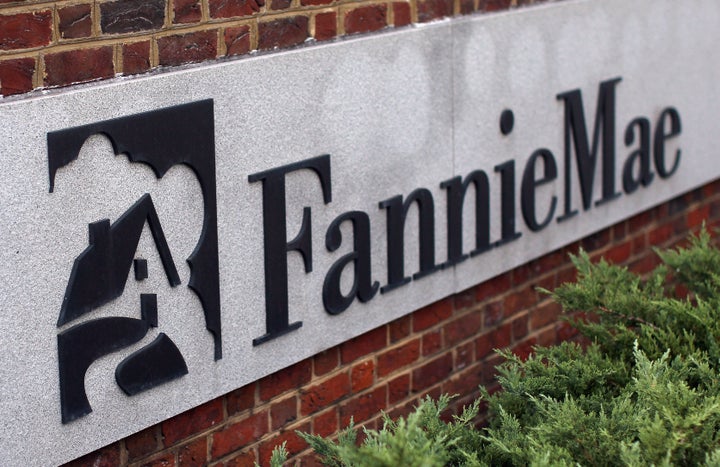
The Securities and Exchange Commission sued six former Fannie Mae and Freddie Mac executives on Friday for misleading the public about the mortgage giants' exposure to risky subprime mortgages as the housing bubble deflated.
Former Fannie Mae chief executive Daniel Mudd and former Freddie Mac CEO Richard Syron are the highest-ranking officials yet to be charged for their involvement in the housing meltdown that triggered the biggest financial collapse since the Great Depression. Along with four other former executives for the companies, they are accused of fraud, under-representing the amount of exposure the finance companies had to dodgy mortgages.
The SEC action, filed in U.S. district court in New York, is the latest signal that federal agencies are cracking down on the executives who were at the helm of the nation's largest financial firms during the housing bust. Earlier this week three former top Washington Mutual executives settled a lawsuit with the Federal Deposit Insurance Corporation for $64 million for their actions during the subprime lending disaster.
Also charged with fraud: former Fannie Mae chief risk officer Enrico Dallavecchia, former Fannie Mae executive vice president Thomas Lund, and former Freddie Mac executive vice presidents Patricia Cook and Donald Bisenius.
"Fannie Mae and Freddie Mac executives told the world that their subprime exposure was substantially smaller than it really was," said Robert Khuzami, director of the SEC's enforcement division, in a statement.
The SEC alleges that Freddie Mac systematically understated its exposure to subprime mortgages. Freddie Mac stated in its public filings that its exposure of subprime mortgages was only one to two percent of the amount actually held, according to the SEC.
In early 2007, with the housing market beginning its tumble, Freddie Mac claimed it held just $2 billion in subprime loans. The company was in fact exposed to $141 billion in subprime loans at the end of 2006, a number comprising 10 percent of its entire single-family portfolio, according to the SEC.
The SEC claims that by the summer of 2008 Freddie's exposure to subprime loans had grown to $244 billion, comprising 14 percent of its single-family portfolio. That summer, Freddie allegedly claimed only $6 billion of its loans to be subprime.
Fannie Mae similarly excluded 90 percent -- or $43.3 billion -- of its subprime single-family mortgage portfolio from a public filing by labeling those mortgages differently in February 2007, according to the SEC.
In another instance, Fannie Mae failed to report 39 percent of its low-documentation loans in a May 2007 filing, according to the SEC. While the company publicly reported about 11 percent of its single-family mortgages were low-documentation loans, they in fact comprised 17.9 percent of its portfolio, the SEC alleges.
The SEC has entered into non-prosecution agreements with Fannie Mae and Freddie Mac, in part because the companies are currently under government conservatorship. Under the non-prosecution agreements, both companies agreed upon a set of facts about the company's respective actions with regard to the alleged fraud. In exchange for agreeing to these statements of fact, and agreeing to cooperate with the SEC, the SEC will not sue either of the companies. The facts will remain in the public record, however, and could be used by individual investors who want to bring securitization claims against the companies at some future date.
"We are pleased to bring the SEC inquiry to a close," Fannie Mae said in a statement. "We continue to focus on our priorities of providing critical funding to a fragile housing market, helping distressed homeowners, and helping build a sustainable housing finance system for the future."
The SEC has been under increased pressure to hold executives accountable for the financial crisis, even as budget concerns loom. SEC chairwoman Mary Schapiro said in February that the agency doesn't have enough money to police Wall Street or draft new regulations required by the Dodd-Frank financial reform law.
But for some, the SEC's lawsuit against Fannie and Freddie doesn't do enough to address the larger issues at hand.
"It's not just that it's too little too late, but that this is just icing on the cake," said Diane Thompson, a lawyer with the National Consumer Law Center. "Meanwhile, we don't have a cake. We don't even have bread. We have millions of people losing their homes and we aren't doing anything about it."
Back in 2008, as Fannie and Freddie were collapsing, both Mudd and Syron defended the companies' entrance into the subprime mortgage market in the lead up to the financial crisis, saying the companies felt pressure to take on riskier loans to keep pace with competitors. They added that as the housing market entered a free fall, they were faced with conflicting pressures from shareholders, regulators and Congress.
Mudd, now chief executive of the hedge fund Fortress Investment Group, continued to defend himself after the lawsuit was announced, saying in a statement that the federal government and investors knew about "every piece of material data about loans held by Fannie Mae."
"The government reviewed and approved the company's disclosures during my tenure, and through the present," Mudd's statement said. "Now it appears that the government has negotiated a deal to hold the government, and government-appointed executives who have signed the same disclosures since my departure, blameless -- so that it can sue individuals it fired years ago."
Both Mudd and Syron received letters from the SEC indicating that the agency is planning to bring an enforcement action earlier this year. Syron's attorney, Thomas Green, told the Wall Street Journal in March that the proposed charges in the Wells notice were "completely without merit."
Mudd himself stated in March that he planned to submit a rebuttal to the allegations.
"I have the highest respect for the commission. Nevertheless, I could not disagree more with this turn of events," Mudd said in the statement.
Mudd, who took the reins of Fannie Mae in 2005 and was ousted after the government took over the company in 2008, told Bloomberg in a 2006 interview that he planned to include more high-risk loans in the company's profile. That same year he told investors that doing anything else would be "counterproductive."
"Fannie Mae faced the danger that the market would pass us by," he told the The New York Times in October 2008. "We were afraid that lenders would be selling products we weren't buying and Congress would feel like we weren't fulfilling our mission. The market was changing, and it's our job to buy loans, so we had to change as well."
Syron, who left his post at Freddie Mac days after it went into government conservatorship, also pushed Freddie Mac to take riskier positions even after repeated warnings, according to a separate report in The New York Times.
David Andrukonis, Freddie Mac's former chief risk officer, told the The New York Times in 2008 that he had warned Syron in mid-2004 that Freddie was taking on loans that would likely pose an "enormous" risk, but Syron refused to consider these possibilities, Andrukonis said. Syron told the The New York Times he had limited options at the time.
"If I had better foresight, maybe I could have improved things a little bit," he told the New York Times in 2008. "But frankly, if I had perfect foresight, I would never have taken this job in the first place."
Loren Berlin contributed reporting to this story.
SEC Complaint vs. Fannie Mae Executives:
SEC Complaint vs. Freddie Mac Executives:
